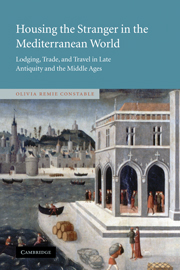 Housing the Stranger in the Mediterranean World
Housing the Stranger in the Mediterranean World Published online by Cambridge University Press: 27 August 2009
As the Byzantine cities of the Near East came under Muslim rule, much of their urban infrastructure and their institutions, including the pandocheion, were absorbed into the new Muslim context. Many aspects of early Muslim urban administration and architecture were based on Byzantine prototypes and modified to suit the needs of the new Islamic milieu. Umayyad caliphs and their regional governors followed a program of incorporation, reform, and innovation. They initially worked with the Byzantine bureaucratic and fiscal institutions already in place in Syria and Egypt, then gradually initiated changes as the process of creating a Muslim polity continued. By the early eighth century, this shift was well under way, with a vigorous program of building projects, tax reforms, changes in coinage, and other economic and administrative innovations, especially during the reigns of the Umayyad caliphs ʿAbd al-Malik (685–705) and Hishām (724–743). Over time, an Arabic institutional vocabulary emerged, often employing older and familiar terms for Islamic structures that resembled but did not, in fact, exactly reproduce earlier forms.
Funduqs, which appear in Arabic texts by the ninth century, were among a number of institutions adopted and adapted from an earlier Greek model. These hostels shared many functional characteristics with pandocheions, as well as a cognate name, but they also evolved their own identity. The funduq would continue to change over time, shifting to suit the needs of period and place, yet preserving continuities in name and many basic features.
To save this book to your Kindle, first ensure no-reply@cambridge.org is added to your Approved Personal Document E-mail List under your Personal Document Settings on the Manage Your Content and Devices page of your Amazon account. Then enter the ‘name’ part of your Kindle email address below. Find out more about saving to your Kindle.
Note you can select to save to either the @free.kindle.com or @kindle.com variations. ‘@free.kindle.com’ emails are free but can only be saved to your device when it is connected to wi-fi. ‘@kindle.com’ emails can be delivered even when you are not connected to wi-fi, but note that service fees apply.
Find out more about the Kindle Personal Document Service.
To save content items to your account, please confirm that you agree to abide by our usage policies. If this is the first time you use this feature, you will be asked to authorise Cambridge Core to connect with your account. Find out more about saving content to Dropbox.
To save content items to your account, please confirm that you agree to abide by our usage policies. If this is the first time you use this feature, you will be asked to authorise Cambridge Core to connect with your account. Find out more about saving content to Google Drive.